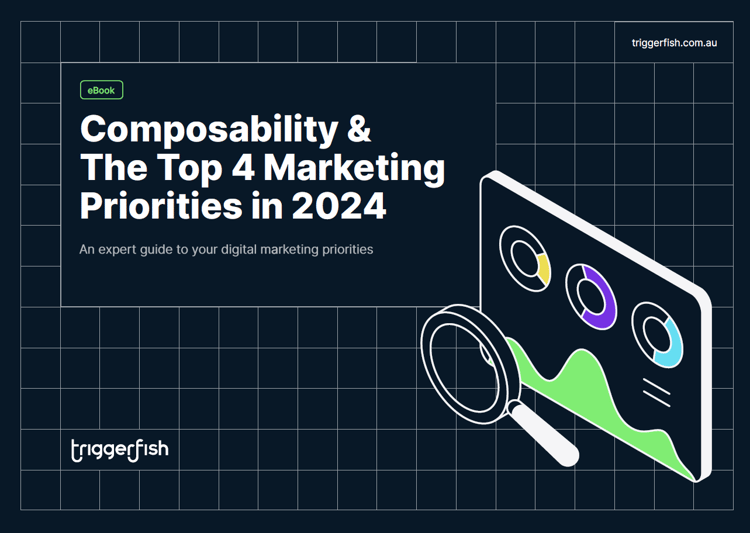Welcome to part 2 of our 5-part series that will explore the composable strategies and the top 4 marketing priorities in 2024.
With the current prominence of composable technologies, Chief Marketing Officers (CMOs), Chief Technology Officers (CTOs), and Chief Information Officers (CIOs), face a crucial business question: Are the technology-driven benefits for composable technologies aligned with business and marketing goals?According to Gartner, while composability is gaining traction, not all businesses are well-positioned to harness its full potential. Read related article Five Levels of Composability Readiness.
At Triggerfish, we’ve identified the top 4 marketing priorities that are crucial for CMOs and organisations assessing composable technologies in 2024.
These include:
- Personalisation Effectiveness
- Data-Driven Engagement
- Strategic Budget Allocation
- Modernising Team Structure
Establishing and implementing business-wide personalisation strategies for target markets and customer segments.
It’s time to make Personalisation a strategic business function. Personalisation in marketing involves customising content, products, services, and experiences to individual customers based on their preferences, behaviours, and history. This helps create a more personal and meaningful interaction between the brand and the customer.According to McKinsey, businesses that offer effective personalisation generate 40% more revenue than other companies. Customers who recognise value in their experience are also more likely to become loyal consumers, leading to repeat business transactions and a trust-based relationship.
However, personalisation presents challenges in capturing meaningful data, user identification and
maintaining user privacy. Web identifiers and browser cookies are gradually being phased out. This shift considerably affects existing data-driven marketing strategies, potentially rendering them obsolete.
Therefore, a move towards first-party data is necessary and will ultimately save on expenses. According to Deloitte, CMOs expect to use first-party data (75%) compared to second-party data (46%) and third-party data (39%) in the next two years.
Optimising personalisation by correctly identifying users and target audiences
Identifying website visitors is critical to maximising personalisation in a world moving away from cookies. It helps organisations link (anonymous) visitors to identified contact or account information. Here are the top strategies to navigate this complex process:
- Encourage users to create accounts or join loyalty programs with incentives: Encouraging users to create accounts or enrol in loyalty programs not only facilitates data collection but also builds a stronger relationship. By offering incentives like exclusive discounts or personalised perks, you motivate users to willingly share their information.
- Offer opt-in opportunities for users to subscribe to content or updates: Providing opt-in options for content or updates respects user preferences and establishes a direct communication channel. Users who willingly subscribe are more likely to engage with your organisation, fostering a sense of loyalty and interest.
- Use IndexedDB for cookie-less user session tracking: Implementing IndexedDB for user session tracking is a strategic move in response to evolving privacy concerns. This approach ensures a more secure and user-friendly experience by sidestepping traditional cookies.
- Collect personal information through forms and surveys: Gathering personal information through forms and surveys allows for a deeper understanding of user preferences. This valuable data aids in tailoring personalised experiences, ensuring that your offerings align closely with the needs and expectations of your audience.
- Leverage social media integration for identifying and connecting users to known contacts: Integrating social media not only enhances user identification but also facilitates meaningful connections. By leveraging social platforms, businesses can tap into existing networks, linking users to known contacts and broadening the scope of personalised interactions.
- Integrate data across multiple platforms for linking anonymous users to known contacts: Integrating data across diverse platforms is crucial for creating a comprehensive user profile. This strategy enables businesses to bridge the gap between anonymous users and known contacts, providing a holistic view that contributes to more effective personalised experiences.
Understanding User Intent for Effective Personalisation
Personalisation effectiveness varies depending on the degree of intent recorded for use and the level of explicit personalisation utilised. Identifying their wants and needs enables businesses to offer the right products or services. Here are four intent types that can guide personalisation strategies:
- Contextual intent: Personalisation based on keywords or search ads when users arrive on the website.
- Behaviour-based intent: Personalisation using browsing history and previous content engagement data.
- Stated intent: Personalisation by explicitly asking about users’ needs or areas of interest on the site.
- Profiled intent based on customer experience journey: Customer profiling using and integrating customer data from other platforms.
Adopting personalisation as a strategic business function is imperative for fostering meaningful brand-customer interactions and driving revenue growth. Despite challenges in data capture and user privacy, a shift towards first-party data is crucial for adapting to evolving marketing landscapes. Implementing user identification strategies and understanding diverse user intents further contributes to the foundation for successful and effective personalised experiences in the ever-changing digital landscape.
To continue reading about composability, download our eBook.
.png)




